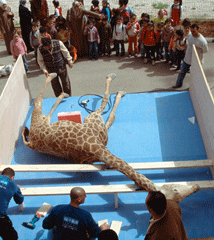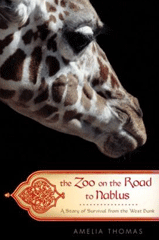The Zoo on the Road to Nablus
Air Date: Week of June 6, 2008

Brownie the giraffe died in the Qalqilya Zoo after getting spooked by nearby gunfire. (Photo: Peter Friedl)
The only remaining zoo in the West Bank opened in 1986, a year before the first Palestinian intifada. Amelia Thomas tells the story of how it's survived the violence and poverty of the occupied territory in her new book "The Zoo on the Road to Nablus: A Story of Survival from the West Bank." Living on Earth host Bruce Gellerman talks with Thomas about the animals and people that keep the zoo open.
Transcript
GELLERMAN: Zoos are fun, they’re educational, a normal part of childhood. But for a Palestinian kid living on the West Bank – the Qalqilya Zoo is much more – it’s a refuge from barricades, checkpoints and chaos. The Qalqilya Zoo has survived bombs and bullets – it’s the only zoo in the West Bank, and it’s run by the only zoo vet in the Palestinian territories.
Amelia Thomas writes about the zoo-keeper and his animals in her new book "The Zoo on the Road to Nablus: A story of Survival from the West Bank." And she joins me now from Jerusalem. Welcome, Amelia.
THOMAS: Thank you very much for having me.
GELLERMAN: This is a very unlikely place to put a zoo at a very inopportune time. Why a zoo in Qalqilya?
THOMAS: The zoo in Qalqilya is one of the only things now for the public to do in the West Bank. There's pretty much no other kind of leisure activities there at all. Qalqilya itself is a town on the very edge of the West Bank, so it's one of the closest towns to Israel. As a journalist I was intrigued by the idea that there could even be a zoo in Qalqilya in the West Bank, and I heard about it in a tiny little news article, a Palestinian news article, so I went to have a look and see if it was really true. And it was.

THOMAS: (laughs) Ya, it's not what we could consider to be a zoo of any kind of Western caliber. It's a small zoo right in the center of town, so there's very little room for expansion there, and they've had to struggle against some pretty difficult situations – through two Intifadas where there's been a lot of shooting, a lot of curfews. But the head vet there, the only vet there, who's the only Palestinian zoo vet and who I follow in the story, has this dream to turn it into an international zoo, he calls it.
GELLERMAN: Dr. Codder- or you call him Dr. Sammy - is sort of an unlikely heroic figure.
THOMAS: (laughs)
GELLERMAN: He's kind of rolly polly with a moustache, is the way I kind of envision him.
THOMAS: (laughs) Yeah. He's, um, he’s not your average hero, definitely. He's, as you say, he's a little chubby, and a little scruffy as well, but he has been the one who has kept the zoo going through its hardest periods. Dr. Sammy's always sort of managed to find some way of looking on the positive side of even the direst of circumstances. When animals have been killed in a - especially in the Second Intifada, several animals were killed during fighting - instead of giving up and saying, well there's no way we're gonna get another zebra, he, he turned to stuffing them.
GELLERMAN: He's a taxidermist and he starts stuffing the animals, and that's just ok with him, that's, you know, a solution.
THOMAS: Ya. Because that meant that he would, he'd, okay! He'd start a natural history museum and make the best of a bad situation.
GELLERMAN: He's got these rusting cages and rather than leave them empty, he finds some chickens and put them in there because he, 'you can't have a cage with no animals in them,' he says.
THOMAS: That's right. The main reason that he keeps his zoo going is for, is for the people of the town and the people of the region when they can get there. And his idea is, you know, no one wants to see an empty cage. So if you have an empty cage, because an animal’s died or you can't get any new animals, find something to put in it. So, people of the town have brought in animals that they've found, so he's got a badger, and he's got some ducks. So in hardest times, a lot of the cages were filled with chickens.
GELLERMAN: The town's surrounded by part of the security wall.
THOMAS: That's right. It's almost surrounded 360 degrees by the security wall barrier, so it limits movement a lot. The only way in and out is one checkpoint, which is fairly regularly closed and is policed.
GELLERMAN: How did you get back and forth through the security fence?
THOMAS: As a journalist, you're allowed pretty much free access into the West Bank and into Israel and into Gaza. So I was allowed this kind of viewpoint that very few people really are allowed, and by traveling to and from Qalqilya fairly freely, it's kind of a tricky thing when you see yourself show a card and you go straight through, and you know that there's people in Qalqilya who haven't been allowed out of the town for years. They can't go and visit their relatives, they can't travel, they can't even get to the next town or to the places where they would traditionally have sent their goods to market.
GELLERMAN: Is it overwrought to think that when writing this book, you used the zoo as a metaphor for Qalqilya? Am I reading too much into it?
THOMAS: I think that that's absolutely true. I think, and it's not only a metaphor for Qalqilya but probably a metaphor for sort of the broader Palestinian situation and many situations within the Middle East where people are sort of caught up in what they would consider to be cages.
GELLERMAN: One of the characters in the book is Ruti, the giraffe.
THOMAS: Ya.
GELLERMAN: And uh, her mate is murdered.
THOMAS: Brownie was found for Ruti so that she'd have a mate, and it's very difficult to get any animals into Qalqilya at all, let alone a giraffe. So he was finally found for her, and slowly, they fell in love. She was the instigator. And during the Second Intifada one night, troops stationed themselves at a boy's school, which backs onto the zoo, and as darkness fell, started shooting into the zoo - we assume that was because they've spotted militants. And uh, the sound of the gunfire startled Brownie. He ran from the gunfire, hit his head on the door of the giraffe night enclosure, and that killed him unfortunately.

Brownie the giraffe died in the Qalqilya Zoo after getting spooked by nearby gunfire. (Photo: Peter Friedl)
THOMAS: Yeah, zoos in wartime have always, they've always in a way reflected the situation of the country itself. During the Second World War, zoos in Britain, but also in Germany, suffered a lot under bombings, and what intrigued me a little bit more about the Palestinian situation rather than the other zoos was that in Qalqilya, nobody seemed to come in to help. In Iraq and in Afghanistan, international aid was sent in, people brought supplies for the animals, people brought vets, people donated to funds to help these zoos. And Qalqilya, they sort of seem to be a little bit forgotten.
GELLERMAN: Well, there's this absurd quality to what's going on there. There's a man with a mission to build a zoo, and there's war going on, an Intifada. It just, it's so absurd.
THOMAS: Often you do sort of look away for a minute when you read the newspaper or go out and to tell a story and just think how absurd the situation is in this region. One of the things that struck me particularly when I was, when I was writing this story and researching in Qalqilya, was that the contrast between one side of the security wall, inside Qalqilya, and the other side, outside Qalqilya in Israel, was so stark. You know, in one side of the fence, people are driving nice cars and drinking wine at lunchtime, and on the other side of the fence, really none of that is going on - people are going down the road in donkey carts - and so, yeah, there's an absolute absurdity to the situation.
GELLERMAN: So what happens now, Amelia, what happens to the zoo now?
THOMAS: Things have been slowly, gradually, improving. There's a point in the story where I talk about Dr. Sammy's new project, which is the 'Museum of Everything,' (laughs) which is his third museum. And his first museum was the natural history museum, the second museum was an agricultural museum, and after that he decided to broaden it out a little bit and create a museum of everything. And that's since opened, so he's created a huge Papier-mâché space shuttle and a massive dinosaur and a volcano, which allegedly erupts, although I've never seen it erupt. (laughs) And so he's, yeah he's pressing on and planning new things for a monkey enclosure, which is going to be a new enclosure for his fairly motley collection of monkeys. It's never easy to say what will happen in this region of the world, and things can change, you know, overnight. But he's tenacious, and he doesn't want to give up, and I think he'll keep on going until he gets what he wants.
GELLERMAN: Amelia Thomas is a correspondent for the Christian Science Monitor, The Middle East Times, and Lonely Planet. Her new book is called, 'The Zoo on the Road to Nablus: A Story of Survival from the West Bank.' Amelia, thank you so much.
THOMAS: Oh, thank you for having me.
Living on Earth wants to hear from you!
Living on Earth
62 Calef Highway, Suite 212
Lee, NH 03861
Telephone: 617-287-4121
E-mail: comments@loe.org
Newsletter [Click here]
Donate to Living on Earth!
Living on Earth is an independent media program and relies entirely on contributions from listeners and institutions supporting public service. Please donate now to preserve an independent environmental voice.
NewsletterLiving on Earth offers a weekly delivery of the show's rundown to your mailbox. Sign up for our newsletter today!
 Sailors For The Sea: Be the change you want to sea.
Sailors For The Sea: Be the change you want to sea.
 The Grantham Foundation for the Protection of the Environment: Committed to protecting and improving the health of the global environment.
The Grantham Foundation for the Protection of the Environment: Committed to protecting and improving the health of the global environment.
 Contribute to Living on Earth and receive, as our gift to you, an archival print of one of Mark Seth Lender's extraordinary wildlife photographs. Follow the link to see Mark's current collection of photographs.
Contribute to Living on Earth and receive, as our gift to you, an archival print of one of Mark Seth Lender's extraordinary wildlife photographs. Follow the link to see Mark's current collection of photographs.
 Buy a signed copy of Mark Seth Lender's book Smeagull the Seagull & support Living on Earth
Buy a signed copy of Mark Seth Lender's book Smeagull the Seagull & support Living on Earth

